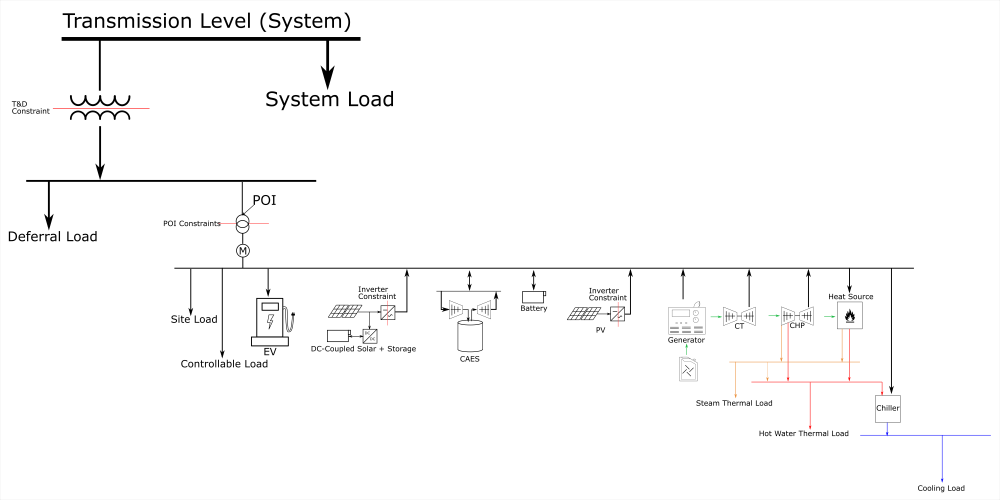Difference between revisions of "DER VET User Guide"
m (→About) |
|||
| (One intermediate revision by one other user not shown) | |||
| Line 48: | Line 48: | ||
= About = | = About = | ||
DER-VET v1. | DER-VET v1.3 | ||
Copyright © | Copyright © 2024 Electric Power Research Institute, Inc. All Rights Reserved. | ||
Permission to use, copy, modify, and distribute this software for any purpose | Permission to use, copy, modify, and distribute this software for any purpose | ||
| Line 71: | Line 71: | ||
below. | below. | ||
CVXPY/1. | CVXPY/1.4.2 - Steven Diamond, diamond@cs.stanford.edu | ||
Copyright © 2017 Steven Diamond | Copyright © 2017 Steven Diamond | ||
Latest revision as of 22:00, 17 December 2024
User Guide and Technical Documentation for the Distributed Energy Resources Value Estimation Tool (DER-VET™)
DER-VET provides a free, publicly accessible, open-source platform for calculating, understanding, and optimizing the value of distributed energy resources (DER) based on their technical merits and constraints. An extension of EPRI's StorageVET® tool, DER-VET supports site-specific assessments of energy storage and additional DER technologies—including solar, wind, demand response, electric vehicle charging, internal combustion engines, and combined heat and power—in different configurations, such as microgrids or standalone resources. It uses load and other data to determine optimal size, duration, and other characteristics for maximizing benefits based on site conditions. Customers, developers, utilities, and regulators across the industry can apply this tool to inform project-level or broader decisions based on sound technical understanding and unbiased cost-performance data.
DER-VET was developed with funding from the California Energy Commission. EPRI plans to support continuing updates and enhancements.
Introduction to DER-VET
DER-VET is an open-source, optimization-based planning tool to aid in the design of distributed energy resource and microgrid deployments to maximize benefit to individual customers, ratepayers, and to society. DER-VET provides a platform to model the operation and subsequent value of a set of DERs (“DER mix”), potentially configured in a microgrid, collectively providing a set of stacked services. DER-VET uses load and other site-specific data to optionally optimize the size of the DERs concurrently with its dispatch optimization. The technologies modeled in DER-VET include various types of energy storage, intermittent renewable generation, fueled generation, controllable loads/electric vehicles, and hybrid resources like combined heat and power (CHP). These energy resources can be used in any combination to improve grid reliability, improve customer resilience by providing backup to local critical loads, decrease the electricity bill incurred by the site, participate in wholesale energy or ancillary services markets, provide demand response or resource adequacy, or some allowable combination of these. DER-VET could be connected with the grid simulation tools (for example OpenDSS™, DRIVE, etc.) to allow for easy transitions between the models.
It is the next generation of EPRI’s energy storage and distributed energy resources valuation tools. It expands the functionality, accessibility, and transparency of the previous two iterations of EPRI’s storage valuation tools, the Energy Storage Valuation Tool (ESVT), then the Storage Value Estimation Tool (StorageVET 1.0 & 2.0). The analytical core of the tool has been written in the free and increasingly popular Python programming language. As an open-source tool, DER-VET seeks to leverage the culture of community feedback and support of its users and the free-to-use libraries in Python.
DER-VET is most commonly used to address the following questions:
- Could a specific set of DERs recover their costs by providing a specific set of services over their life?
- What is the optimal size for a DER providing economic services (e.g. customer bill reduction, wholesale market participation)?
- What is the minimum DER size required to meet a reliability objective, such as backup power or distribution upgrade deferral?
- What product offering could achieve the most favorable financial results for a specific application?
Index
About
DER-VET v1.3
Copyright © 2024 Electric Power Research Institute, Inc. All Rights Reserved.
Permission to use, copy, modify, and distribute this software for any purpose with or without fee is hereby granted, provided that the above copyright notice and this permission notice appear in all copies.
THIS SOFTWARE IS PROVIDED BY THE COPYRIGHT HOLDERS AND CONTRIBUTORS "AS IS" AND ANY EXPRESS OR IMPLIED WARRANTIES, INCLUDING, BUT NOT LIMITED TO, THE IMPLIED WARRANTIES OF MERCHANTABILITY AND FITNESS FOR A PARTICULAR PURPOSE ARE DISCLAIMED. IN NO EVENT SHALL EPRI BE LIABLE FOR ANY DIRECT, INDIRECT, INCIDENTAL, SPECIAL, EXEMPLARY, OR CONSEQUENTIAL DAMAGES (INCLUDING, BUT NOT LIMITED TO, PROCUREMENT OF SUBSTITUTE GOODS OR SERVICES; LOSS OF USE, DATA, OR PROFITS; OR BUSINESS INTERRUPTION) HOWEVER CAUSED AND ON ANY THEORY OF LIABILITY, WHETHER IN CONTRACT, STRICT LIABILITY, OR TORT (INCLUDING NEGLIGENCE OR OTHERWISE) ARISING IN ANY WAY OUT OF THE USE OF THIS SOFTWARE, EVEN IF ADVISED OF THE POSSIBILITY OF SUCH DAMAGE.
Third-Party Software EPRI does not own any portion of the software that is attributed below.
CVXPY/1.4.2 - Steven Diamond, diamond@cs.stanford.edu Copyright © 2017 Steven Diamond
Licensed under the Apache License, Version 2.0 (the "License"); you may not use this file except in compliance with the License. You may obtain a copy of the License at
http://www.apache.org/licenses/LICENSE-2.0
Unless required by applicable law or agreed to in writing, software distributed under the License is distributed on an "AS IS" BASIS, WITHOUT WARRANTIES OR CONDITIONS OF ANY KIND, either express or implied. See the License for the specific language governing permissions and limitations under the License.
CVXPY is provided by the copyright holders and contributors "as is" and any express or implied warranties, including, but not limited to, the implied warranties of merchantability and fitness for a particular purpose are disclaimed.
This software relies on CVXPY to interface with work(s) covered by the following copyright and permission notice(s):
GLPK 5.0 - Andrew Makhorin, mao@gnu.org Copyright © 2000, 2001, 2002, 2003, 2004, 2005, 2006, 2007, 2008, 2009, 2010, 2011, 2012 Andrew Makhorin, Department for Applied Informatics, Moscow Aviation Institute, Moscow, Russia. All rights reserved.
Licensed under GNU Public License v3.0; you may not use GLPK except in compliance with the License. You may obtain a copy of the License at https://www.gnu.org/licenses/gpl-3.0.en.html.
GLPK is a free program and is provided by the copyright holders and contributors "as is" and any express or implied warranties, including, but not limited to, the implied warranties of merchantability and fitness for a particular purpose are disclaimed.

